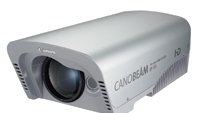Canon unveils HD Canobeam transmission system

At NAB2007, Canon introduced a new version of its Canobeam wireless transmission system that sends uncompressed, HD-SDI and SD-SDI signals via line-of-sight locations. The new DT-150 HD Canobeam transceiver is designed for situations where fiber-optic cables or microwave are impractical options.
Like the rest of the product family, the DT-150 HD Canobeam is a point-to-point optical beam transceiver that uses infrared light to send signals between two locations. The new HD system provides bidirectional, uncompressed 1.5Gb/s transmission of embedded digital video, audio and camera-control signals on a single HD-SDI or SD-SDI stream with no delay.
The DT-150 HD Canobeam has a range of up to half a mile and features Canon's proprietary Auto Tracking feature to maintain beam alignment despite vibration due to wind, rain or unsteady camera platforms.
The HD Canobeam can also relay embedded HD-SDI and SD-SDI video from multiple cameras or other HD/SD video sources, along with embedded return video and audio to the camera operator, camera-control signals and robotic camera-control data.
The wireless infrared transmitter features a Small Form Pluggable (SFP) module system. Each SFP HD module allows the DT-150 HD Canobeam to interface via single-mode fiber LC connectors. Users who are already using single-mode fiber connections can simply plug it into the DT-150 HD Canobeam and instantly transmit embedded video, audio and camera controls via the FSO connection. Those who do not have an existing single-mode fiber connection can use third-party media converters to convert HD-SDI signals or SD-SDI signals from either coaxial or SMPTE hybrid fiber cable into single-mode fiber for transmission. Audio and/or multiple video signals will be embedded into the stream via a multiplexer.
The DT-150 HD uses Free Space Optics, which requires no FCC licensing or frequency coordination. Free Space Optics provides a highly secure and reliable video/audio link that is free from RF interference and signal interception.
For more information, visit www.usa.canon.com.
The professional video industry's #1 source for news, trends and product and tech information. Sign up below.
